Detailed Financial Analysis Report: Emerald Resources NL (ASX: EMR)
VerifiedAdded on 2020/05/16
|9
|2135
|364
Report
AI Summary
This report presents a comprehensive financial analysis of Emerald Resources NL (ASX: EMR), a gold exploration and development company. The analysis evaluates the company's financial condition, focusing on key aspects such as dividend policy, weighted average cost of capital (WACC), return on equity (ROE), return on assets (ROA), and debt ratio. The report examines substantial holders, governance structure, and movements in share prices. Key financial ratios, including ROE, ROA, and debt ratio, are calculated and analyzed over a four-year period. The analysis highlights the company's negative returns and losses from 2015 onwards, impacting ROE and ROA. The report discusses the company's announcements, stock information, and the calculation of the required rate of return using the CAPM formula. The study concludes with a letter of recommendation advising against including the company in an investment portfolio due to its poor financial performance and lack of dividends. The report uses financial data, graphs, and announcements to support its findings, providing a detailed overview of the company's financial health and investment potential. This detailed report is contributed by a student and available on Desklib, the platform providing AI-based study tools.
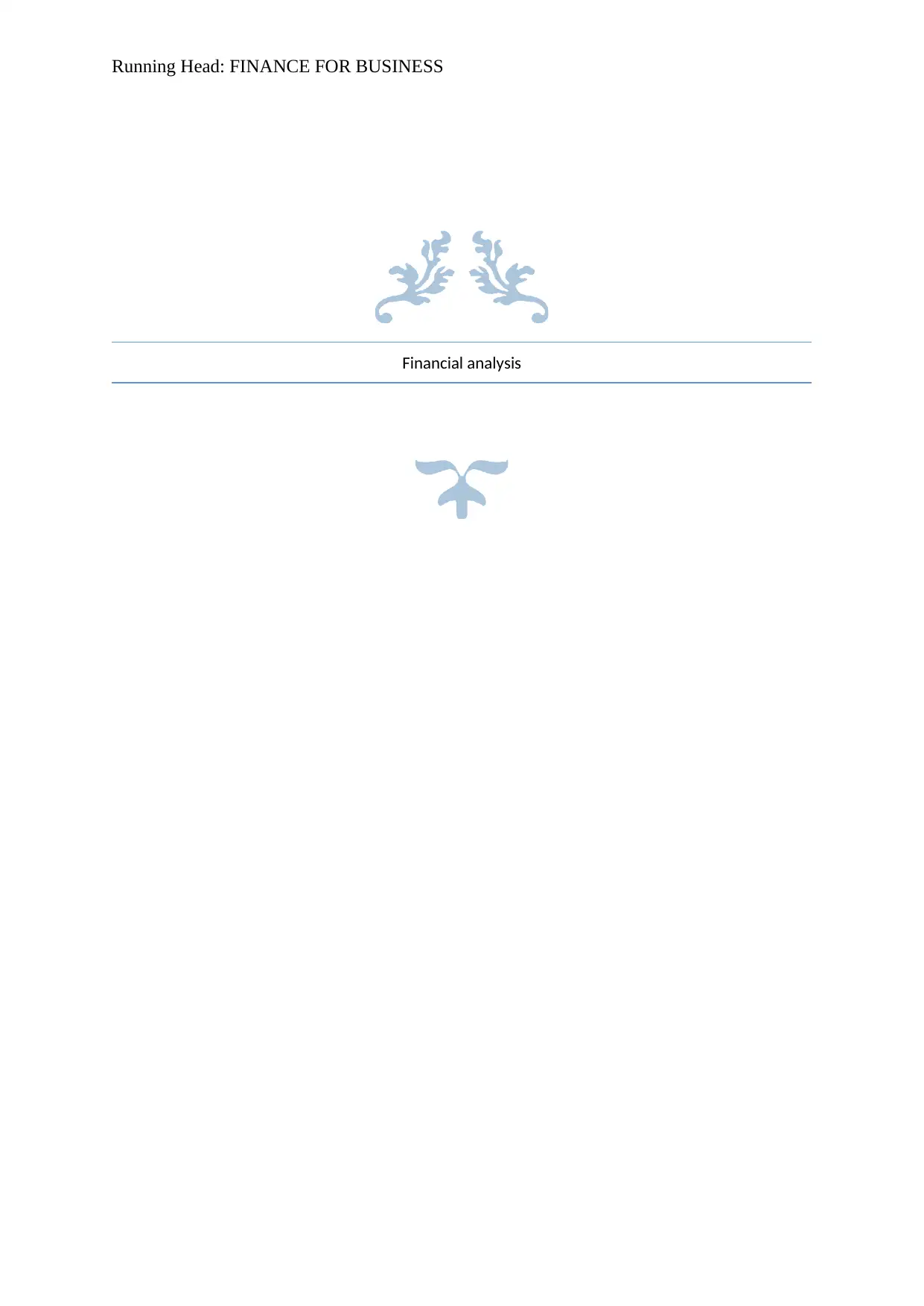
Running Head: FINANCE FOR BUSINESS
Financial analysis
Financial analysis
Paraphrase This Document
Need a fresh take? Get an instant paraphrase of this document with our AI Paraphraser
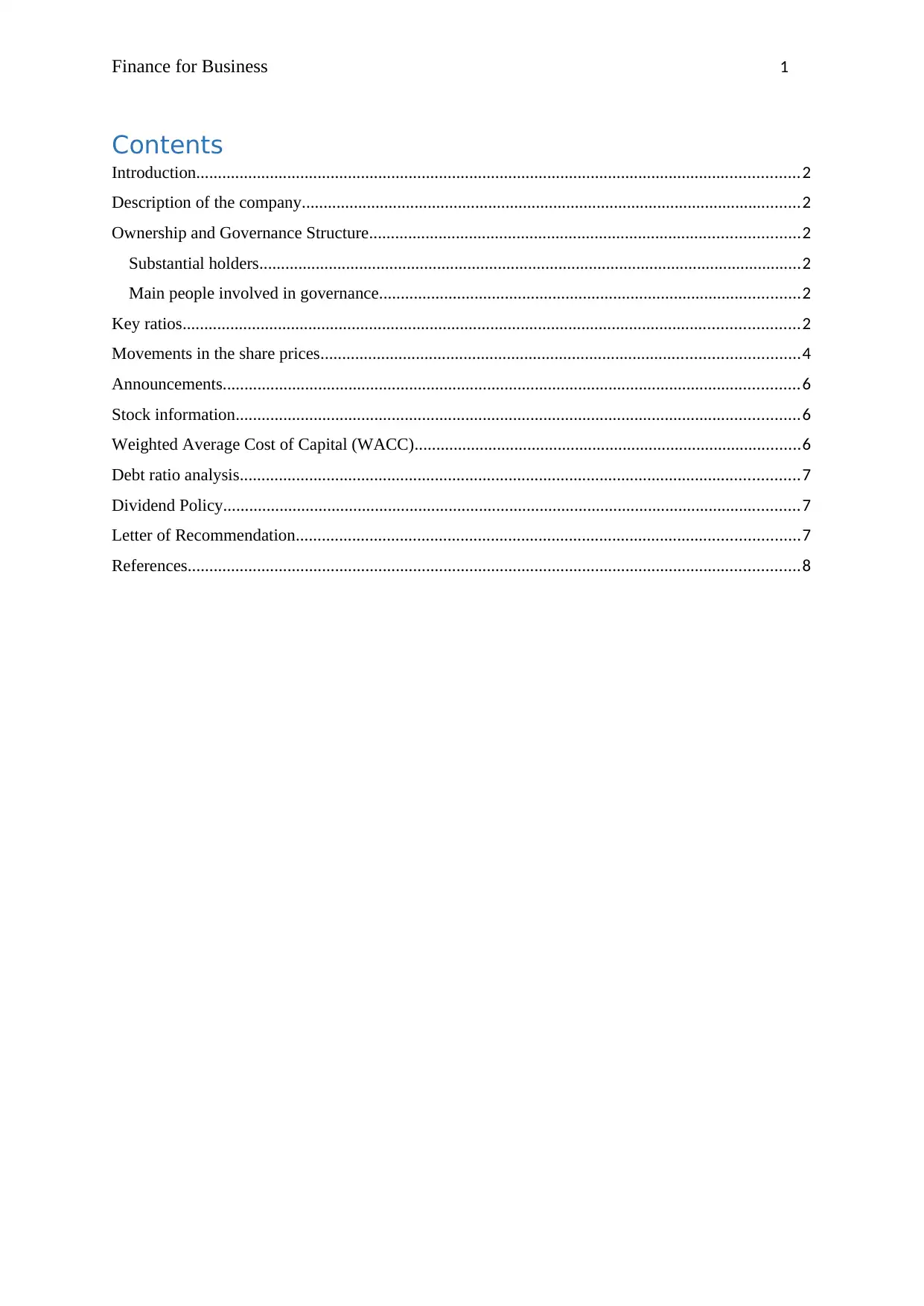
Finance for Business 1
Contents
Introduction...........................................................................................................................................2
Description of the company...................................................................................................................2
Ownership and Governance Structure...................................................................................................2
Substantial holders.............................................................................................................................2
Main people involved in governance.................................................................................................2
Key ratios..............................................................................................................................................2
Movements in the share prices..............................................................................................................4
Announcements.....................................................................................................................................6
Stock information..................................................................................................................................6
Weighted Average Cost of Capital (WACC).........................................................................................6
Debt ratio analysis.................................................................................................................................7
Dividend Policy.....................................................................................................................................7
Letter of Recommendation....................................................................................................................7
References.............................................................................................................................................8
Contents
Introduction...........................................................................................................................................2
Description of the company...................................................................................................................2
Ownership and Governance Structure...................................................................................................2
Substantial holders.............................................................................................................................2
Main people involved in governance.................................................................................................2
Key ratios..............................................................................................................................................2
Movements in the share prices..............................................................................................................4
Announcements.....................................................................................................................................6
Stock information..................................................................................................................................6
Weighted Average Cost of Capital (WACC).........................................................................................6
Debt ratio analysis.................................................................................................................................7
Dividend Policy.....................................................................................................................................7
Letter of Recommendation....................................................................................................................7
References.............................................................................................................................................8
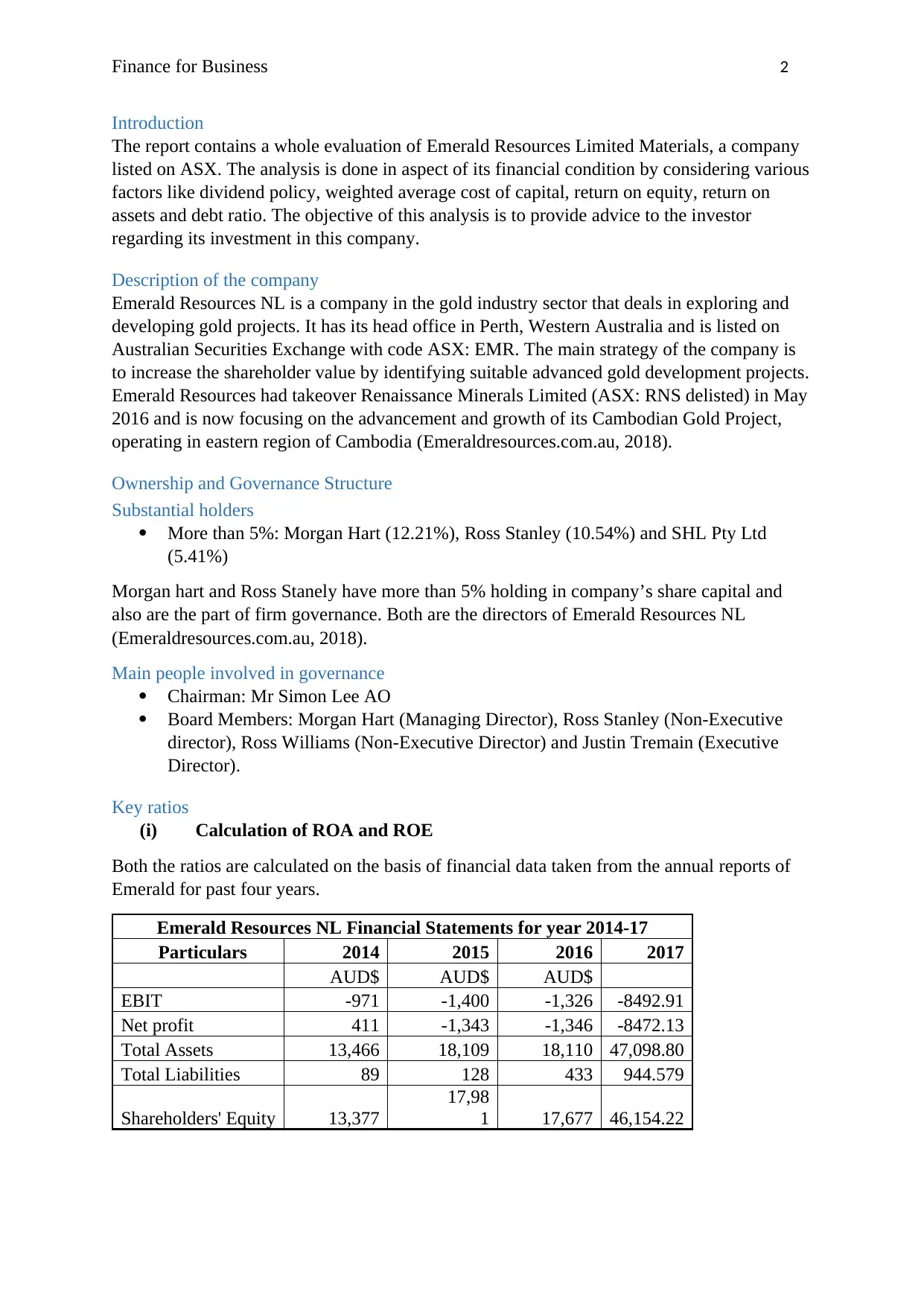
Finance for Business 2
Introduction
The report contains a whole evaluation of Emerald Resources Limited Materials, a company
listed on ASX. The analysis is done in aspect of its financial condition by considering various
factors like dividend policy, weighted average cost of capital, return on equity, return on
assets and debt ratio. The objective of this analysis is to provide advice to the investor
regarding its investment in this company.
Description of the company
Emerald Resources NL is a company in the gold industry sector that deals in exploring and
developing gold projects. It has its head office in Perth, Western Australia and is listed on
Australian Securities Exchange with code ASX: EMR. The main strategy of the company is
to increase the shareholder value by identifying suitable advanced gold development projects.
Emerald Resources had takeover Renaissance Minerals Limited (ASX: RNS delisted) in May
2016 and is now focusing on the advancement and growth of its Cambodian Gold Project,
operating in eastern region of Cambodia (Emeraldresources.com.au, 2018).
Ownership and Governance Structure
Substantial holders
More than 5%: Morgan Hart (12.21%), Ross Stanley (10.54%) and SHL Pty Ltd
(5.41%)
Morgan hart and Ross Stanely have more than 5% holding in company’s share capital and
also are the part of firm governance. Both are the directors of Emerald Resources NL
(Emeraldresources.com.au, 2018).
Main people involved in governance
Chairman: Mr Simon Lee AO
Board Members: Morgan Hart (Managing Director), Ross Stanley (Non-Executive
director), Ross Williams (Non-Executive Director) and Justin Tremain (Executive
Director).
Key ratios
(i) Calculation of ROA and ROE
Both the ratios are calculated on the basis of financial data taken from the annual reports of
Emerald for past four years.
Emerald Resources NL Financial Statements for year 2014-17
Particulars 2014 2015 2016 2017
AUD$ AUD$ AUD$
EBIT -971 -1,400 -1,326 -8492.91
Net profit 411 -1,343 -1,346 -8472.13
Total Assets 13,466 18,109 18,110 47,098.80
Total Liabilities 89 128 433 944.579
Shareholders' Equity 13,377
17,98
1 17,677 46,154.22
Introduction
The report contains a whole evaluation of Emerald Resources Limited Materials, a company
listed on ASX. The analysis is done in aspect of its financial condition by considering various
factors like dividend policy, weighted average cost of capital, return on equity, return on
assets and debt ratio. The objective of this analysis is to provide advice to the investor
regarding its investment in this company.
Description of the company
Emerald Resources NL is a company in the gold industry sector that deals in exploring and
developing gold projects. It has its head office in Perth, Western Australia and is listed on
Australian Securities Exchange with code ASX: EMR. The main strategy of the company is
to increase the shareholder value by identifying suitable advanced gold development projects.
Emerald Resources had takeover Renaissance Minerals Limited (ASX: RNS delisted) in May
2016 and is now focusing on the advancement and growth of its Cambodian Gold Project,
operating in eastern region of Cambodia (Emeraldresources.com.au, 2018).
Ownership and Governance Structure
Substantial holders
More than 5%: Morgan Hart (12.21%), Ross Stanley (10.54%) and SHL Pty Ltd
(5.41%)
Morgan hart and Ross Stanely have more than 5% holding in company’s share capital and
also are the part of firm governance. Both are the directors of Emerald Resources NL
(Emeraldresources.com.au, 2018).
Main people involved in governance
Chairman: Mr Simon Lee AO
Board Members: Morgan Hart (Managing Director), Ross Stanley (Non-Executive
director), Ross Williams (Non-Executive Director) and Justin Tremain (Executive
Director).
Key ratios
(i) Calculation of ROA and ROE
Both the ratios are calculated on the basis of financial data taken from the annual reports of
Emerald for past four years.
Emerald Resources NL Financial Statements for year 2014-17
Particulars 2014 2015 2016 2017
AUD$ AUD$ AUD$
EBIT -971 -1,400 -1,326 -8492.91
Net profit 411 -1,343 -1,346 -8472.13
Total Assets 13,466 18,109 18,110 47,098.80
Total Liabilities 89 128 433 944.579
Shareholders' Equity 13,377
17,98
1 17,677 46,154.22
⊘ This is a preview!⊘
Do you want full access?
Subscribe today to unlock all pages.

Trusted by 1+ million students worldwide

Finance for Business 3
1. Return on Equity
2014 2015 2016 2017
A. Net income available to equity
shareholders. 411 - 1,343 -1,346 -8,472.13
B. Shareholder’s Equity 13,37
7 17,981 17,677 46,154.22
(A/B) 3.07
% -7.47% -7.62% -18.36%
3. Debt Ratio
2014 2015 2016 2017
A. Total Liabilities 89 128 433 944.579
B. Total assets 13,466 18,109 18,110 47,098.80
(A/B) 1% 1% 2% 2%
Proving the equation
EBIT
TA X NPAT
EBIT X TA
OE = NPAT
OE
For 2014
−971
13,466 X 411
−971 X 13,446
13,377 = 411
13,377
-0.07 x -0.42 x 1.01 = 0.03
0.03 = 0.03
For 2015
−1400
18,109 X −1,343
−1400 X 18,109
17,981 =−1,343
17,981
-0.08 x 0.96 x 1.01 = -0.07
-0.07 = -0.07
For 2016
−1,326
18,110 X −1,346
−1326 X 18,110
17,677 =−1,346
17,677
2. Return on Assets
2014 2015 2016 2017
A. Net income 411 -1,343 -1,346 -8472.128
B. Total assets 13,466 18,109 18,110 47,098.80
(A/B) 3.05% -7% -7% -18%
1. Return on Equity
2014 2015 2016 2017
A. Net income available to equity
shareholders. 411 - 1,343 -1,346 -8,472.13
B. Shareholder’s Equity 13,37
7 17,981 17,677 46,154.22
(A/B) 3.07
% -7.47% -7.62% -18.36%
3. Debt Ratio
2014 2015 2016 2017
A. Total Liabilities 89 128 433 944.579
B. Total assets 13,466 18,109 18,110 47,098.80
(A/B) 1% 1% 2% 2%
Proving the equation
EBIT
TA X NPAT
EBIT X TA
OE = NPAT
OE
For 2014
−971
13,466 X 411
−971 X 13,446
13,377 = 411
13,377
-0.07 x -0.42 x 1.01 = 0.03
0.03 = 0.03
For 2015
−1400
18,109 X −1,343
−1400 X 18,109
17,981 =−1,343
17,981
-0.08 x 0.96 x 1.01 = -0.07
-0.07 = -0.07
For 2016
−1,326
18,110 X −1,346
−1326 X 18,110
17,677 =−1,346
17,677
2. Return on Assets
2014 2015 2016 2017
A. Net income 411 -1,343 -1,346 -8472.128
B. Total assets 13,466 18,109 18,110 47,098.80
(A/B) 3.05% -7% -7% -18%
Paraphrase This Document
Need a fresh take? Get an instant paraphrase of this document with our AI Paraphraser

Finance for Business 4
-0.07 x 1.02 x 1.02 = -0.08
-0.08 = -0.08
For 2017
−8,493
47,099 X −8,472
−8,493 X 47,099
46,154 =−8,472
46,154
-0.18 x 1.00x 1.02 = -0.18
-0.18 = -0.18
(ii) In above equation, TA/OE stands for Total Assets/Owners’ Equity. The equity
multiplier is considered as a key factor in DuPont analysis. Having a high equity
multiplier implies that most of the operations of company are financed through
debt. DuPont analysis breaks down ROE into its components which are profit
margin, EBIT, Total assets and Owners’ equity. It deals with the examination of
changes in these components in order to measure corresponding changes in ROE
(Leach and Melicher, 2011).
In relation to Return on Assets, equity multiplier has no or negative relationship
with this ratio. When there is an increase in total assets, multiplier also increases
resulting in the reduction of ROA. On the other side, if there is a rise in sales,
ROA will increase but the multiplier will remain same. So on a whole, a high
equity multiplier will make ROE to rise and ROA to fall. On the other hand,
increase in ROA will result in increase in ROE while the multiplier remains the
same (Brigham and Houston, 2012).
(iii) Only in year 2014, the return on equity of Emerald was more than its ROE, after
that the values of both the ratios are in negative. The reason for negative ROA and
ROE is that the company is making losses from the past three years after 2014.
Company was giving negative returns from 2015 onwards which makes the ROE
negative and less than ROA. One of the reason for this is that the shareholders’
equity was continuously increasing from 2015 to 2017 along with the increase in
the losses. Emerald was not left with enough funds to pay off to its shareholders.
This implies that company is inefficient in managing its owners’ capital whereas it
is bit better at utilizing its assets (Parrino, Kidwell and Bates, 2011).
Movements in the share prices
(i)
-0.07 x 1.02 x 1.02 = -0.08
-0.08 = -0.08
For 2017
−8,493
47,099 X −8,472
−8,493 X 47,099
46,154 =−8,472
46,154
-0.18 x 1.00x 1.02 = -0.18
-0.18 = -0.18
(ii) In above equation, TA/OE stands for Total Assets/Owners’ Equity. The equity
multiplier is considered as a key factor in DuPont analysis. Having a high equity
multiplier implies that most of the operations of company are financed through
debt. DuPont analysis breaks down ROE into its components which are profit
margin, EBIT, Total assets and Owners’ equity. It deals with the examination of
changes in these components in order to measure corresponding changes in ROE
(Leach and Melicher, 2011).
In relation to Return on Assets, equity multiplier has no or negative relationship
with this ratio. When there is an increase in total assets, multiplier also increases
resulting in the reduction of ROA. On the other side, if there is a rise in sales,
ROA will increase but the multiplier will remain same. So on a whole, a high
equity multiplier will make ROE to rise and ROA to fall. On the other hand,
increase in ROA will result in increase in ROE while the multiplier remains the
same (Brigham and Houston, 2012).
(iii) Only in year 2014, the return on equity of Emerald was more than its ROE, after
that the values of both the ratios are in negative. The reason for negative ROA and
ROE is that the company is making losses from the past three years after 2014.
Company was giving negative returns from 2015 onwards which makes the ROE
negative and less than ROA. One of the reason for this is that the shareholders’
equity was continuously increasing from 2015 to 2017 along with the increase in
the losses. Emerald was not left with enough funds to pay off to its shareholders.
This implies that company is inefficient in managing its owners’ capital whereas it
is bit better at utilizing its assets (Parrino, Kidwell and Bates, 2011).
Movements in the share prices
(i)
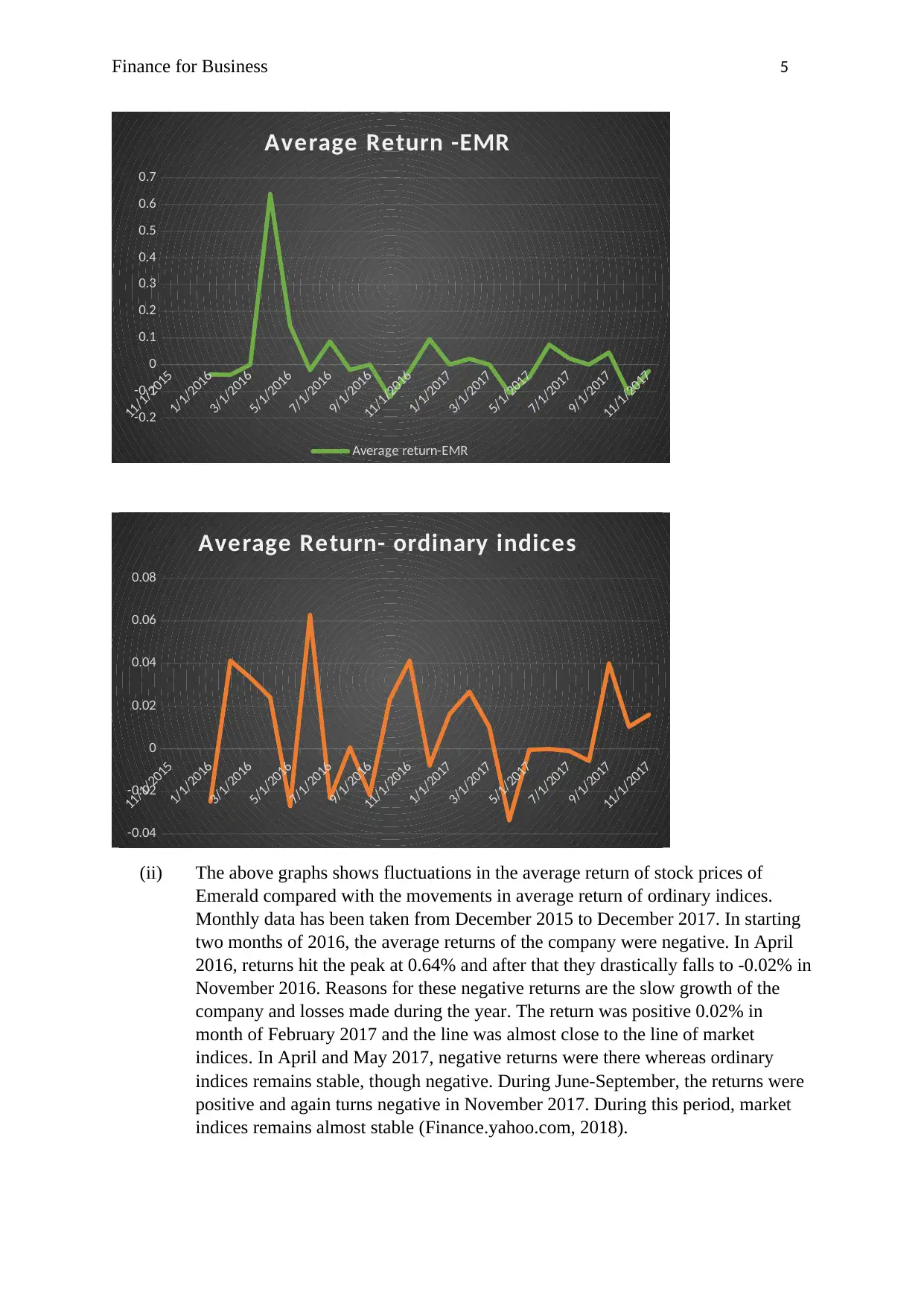
Finance for Business 5
11/1/2015
1/1/2016
3/1/2016
5/1/2016
7/1/2016
9/1/2016
11/1/2016
1/1/2017
3/1/2017
5/1/2017
7/1/2017
9/1/2017
11/1/2017
-0.2
-0.1
0
0.1
0.2
0.3
0.4
0.5
0.6
0.7
Average Return -EMR
Average return-EMR
11/1/2015
1/1/2016
3/1/2016
5/1/2016
7/1/2016
9/1/2016
11/1/2016
1/1/2017
3/1/2017
5/1/2017
7/1/2017
9/1/2017
11/1/2017
-0.04
-0.02
0
0.02
0.04
0.06
0.08
Average Return- ordinary indices
(ii) The above graphs shows fluctuations in the average return of stock prices of
Emerald compared with the movements in average return of ordinary indices.
Monthly data has been taken from December 2015 to December 2017. In starting
two months of 2016, the average returns of the company were negative. In April
2016, returns hit the peak at 0.64% and after that they drastically falls to -0.02% in
November 2016. Reasons for these negative returns are the slow growth of the
company and losses made during the year. The return was positive 0.02% in
month of February 2017 and the line was almost close to the line of market
indices. In April and May 2017, negative returns were there whereas ordinary
indices remains stable, though negative. During June-September, the returns were
positive and again turns negative in November 2017. During this period, market
indices remains almost stable (Finance.yahoo.com, 2018).
11/1/2015
1/1/2016
3/1/2016
5/1/2016
7/1/2016
9/1/2016
11/1/2016
1/1/2017
3/1/2017
5/1/2017
7/1/2017
9/1/2017
11/1/2017
-0.2
-0.1
0
0.1
0.2
0.3
0.4
0.5
0.6
0.7
Average Return -EMR
Average return-EMR
11/1/2015
1/1/2016
3/1/2016
5/1/2016
7/1/2016
9/1/2016
11/1/2016
1/1/2017
3/1/2017
5/1/2017
7/1/2017
9/1/2017
11/1/2017
-0.04
-0.02
0
0.02
0.04
0.06
0.08
Average Return- ordinary indices
(ii) The above graphs shows fluctuations in the average return of stock prices of
Emerald compared with the movements in average return of ordinary indices.
Monthly data has been taken from December 2015 to December 2017. In starting
two months of 2016, the average returns of the company were negative. In April
2016, returns hit the peak at 0.64% and after that they drastically falls to -0.02% in
November 2016. Reasons for these negative returns are the slow growth of the
company and losses made during the year. The return was positive 0.02% in
month of February 2017 and the line was almost close to the line of market
indices. In April and May 2017, negative returns were there whereas ordinary
indices remains stable, though negative. During June-September, the returns were
positive and again turns negative in November 2017. During this period, market
indices remains almost stable (Finance.yahoo.com, 2018).
⊘ This is a preview!⊘
Do you want full access?
Subscribe today to unlock all pages.

Trusted by 1+ million students worldwide
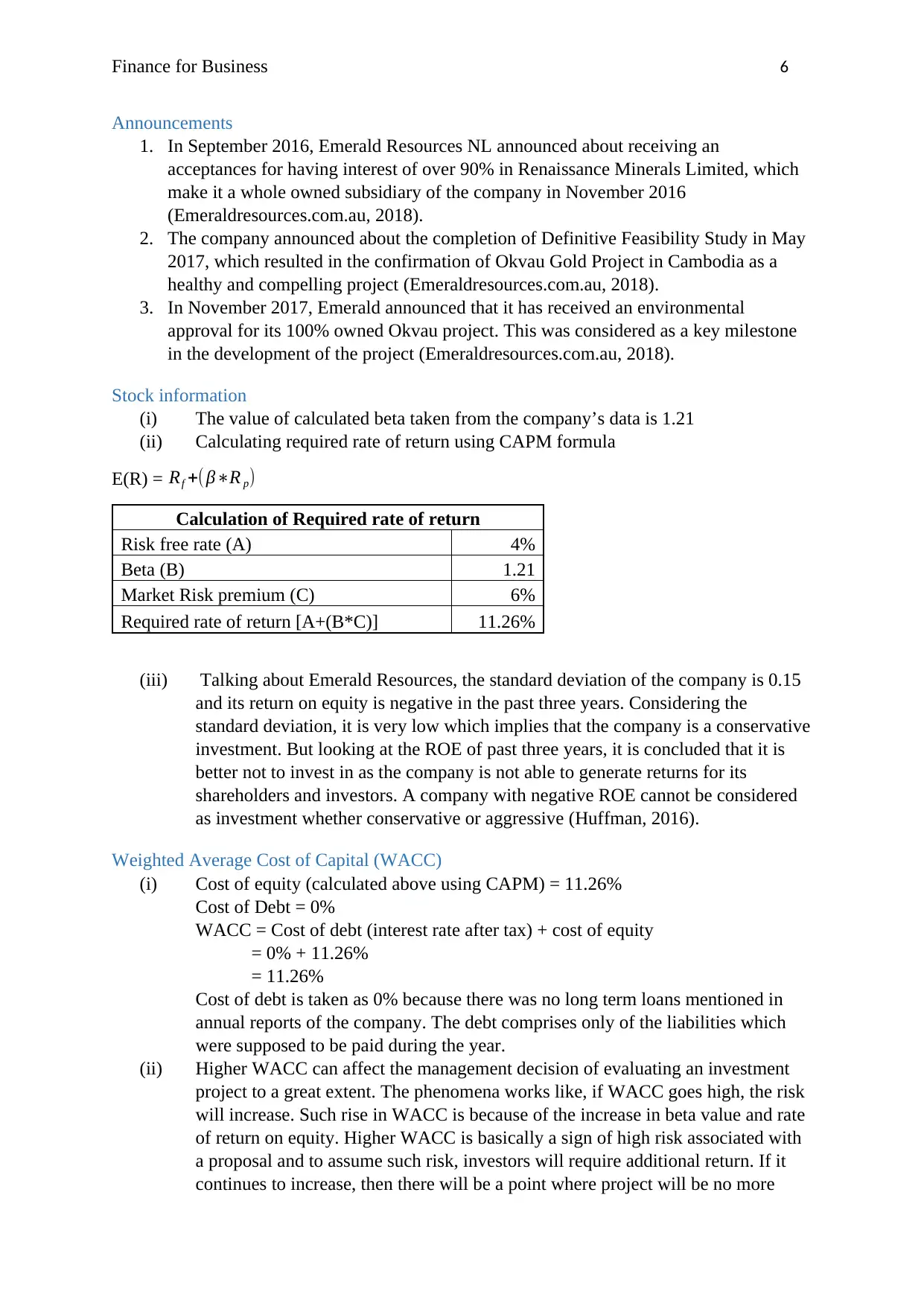
Finance for Business 6
Announcements
1. In September 2016, Emerald Resources NL announced about receiving an
acceptances for having interest of over 90% in Renaissance Minerals Limited, which
make it a whole owned subsidiary of the company in November 2016
(Emeraldresources.com.au, 2018).
2. The company announced about the completion of Definitive Feasibility Study in May
2017, which resulted in the confirmation of Okvau Gold Project in Cambodia as a
healthy and compelling project (Emeraldresources.com.au, 2018).
3. In November 2017, Emerald announced that it has received an environmental
approval for its 100% owned Okvau project. This was considered as a key milestone
in the development of the project (Emeraldresources.com.au, 2018).
Stock information
(i) The value of calculated beta taken from the company’s data is 1.21
(ii) Calculating required rate of return using CAPM formula
E(R) = Rf +( β∗R p)
Calculation of Required rate of return
Risk free rate (A) 4%
Beta (B) 1.21
Market Risk premium (C) 6%
Required rate of return [A+(B*C)] 11.26%
(iii) Talking about Emerald Resources, the standard deviation of the company is 0.15
and its return on equity is negative in the past three years. Considering the
standard deviation, it is very low which implies that the company is a conservative
investment. But looking at the ROE of past three years, it is concluded that it is
better not to invest in as the company is not able to generate returns for its
shareholders and investors. A company with negative ROE cannot be considered
as investment whether conservative or aggressive (Huffman, 2016).
Weighted Average Cost of Capital (WACC)
(i) Cost of equity (calculated above using CAPM) = 11.26%
Cost of Debt = 0%
WACC = Cost of debt (interest rate after tax) + cost of equity
= 0% + 11.26%
= 11.26%
Cost of debt is taken as 0% because there was no long term loans mentioned in
annual reports of the company. The debt comprises only of the liabilities which
were supposed to be paid during the year.
(ii) Higher WACC can affect the management decision of evaluating an investment
project to a great extent. The phenomena works like, if WACC goes high, the risk
will increase. Such rise in WACC is because of the increase in beta value and rate
of return on equity. Higher WACC is basically a sign of high risk associated with
a proposal and to assume such risk, investors will require additional return. If it
continues to increase, then there will be a point where project will be no more
Announcements
1. In September 2016, Emerald Resources NL announced about receiving an
acceptances for having interest of over 90% in Renaissance Minerals Limited, which
make it a whole owned subsidiary of the company in November 2016
(Emeraldresources.com.au, 2018).
2. The company announced about the completion of Definitive Feasibility Study in May
2017, which resulted in the confirmation of Okvau Gold Project in Cambodia as a
healthy and compelling project (Emeraldresources.com.au, 2018).
3. In November 2017, Emerald announced that it has received an environmental
approval for its 100% owned Okvau project. This was considered as a key milestone
in the development of the project (Emeraldresources.com.au, 2018).
Stock information
(i) The value of calculated beta taken from the company’s data is 1.21
(ii) Calculating required rate of return using CAPM formula
E(R) = Rf +( β∗R p)
Calculation of Required rate of return
Risk free rate (A) 4%
Beta (B) 1.21
Market Risk premium (C) 6%
Required rate of return [A+(B*C)] 11.26%
(iii) Talking about Emerald Resources, the standard deviation of the company is 0.15
and its return on equity is negative in the past three years. Considering the
standard deviation, it is very low which implies that the company is a conservative
investment. But looking at the ROE of past three years, it is concluded that it is
better not to invest in as the company is not able to generate returns for its
shareholders and investors. A company with negative ROE cannot be considered
as investment whether conservative or aggressive (Huffman, 2016).
Weighted Average Cost of Capital (WACC)
(i) Cost of equity (calculated above using CAPM) = 11.26%
Cost of Debt = 0%
WACC = Cost of debt (interest rate after tax) + cost of equity
= 0% + 11.26%
= 11.26%
Cost of debt is taken as 0% because there was no long term loans mentioned in
annual reports of the company. The debt comprises only of the liabilities which
were supposed to be paid during the year.
(ii) Higher WACC can affect the management decision of evaluating an investment
project to a great extent. The phenomena works like, if WACC goes high, the risk
will increase. Such rise in WACC is because of the increase in beta value and rate
of return on equity. Higher WACC is basically a sign of high risk associated with
a proposal and to assume such risk, investors will require additional return. If it
continues to increase, then there will be a point where project will be no more
Paraphrase This Document
Need a fresh take? Get an instant paraphrase of this document with our AI Paraphraser

Finance for Business 7
viable and management will decide to quit the investment in that particular
project. Thus, a higher WACC can impact management’s decision concerning
with project evaluation (Mayo, H., 2011).
Debt ratio analysis
(i) The debt ratio of Emerald remains stable from the past two years. In 2017 and
2016, it was 2% and this stability implies that the company raised it funds more
from its investors rather than borrowing. This can be seen from its annual reports
that increase in its total assets is much more than rise in its total liabilities. The
company utilises its assets efficiently in paying off its debt and maintain a
preferred optimal capital structure (Tracy, 2012).
(ii) Gearing ratio mainly includes long term borrowings and as Emerald’s cost of debt
is 0% which means company has no long term debt, so adjustments related them
cannot be made. However, the firm is good at keeping its debt ratio stable from
the past two years.
Dividend Policy
As per the auditor’s report and director’s report, Emerald Resources has not paid any
dividend from the past five years. In past years shareholders who were entitled to receive
dividend has not received the same. As the company is occurring losses from 2015, it is not
able to pay dividends to its shareholders. The company is following no dividend policy and
making losses can be the reason for this.
Letter of Recommendation
On the above analysis, it will be better not to include this company in the investment
portfolio. Various factors like no dividend policy, negative ROE and losses makes the
financial performance of the company poor and not suitable for making investment. So, from
the report, it can be concluded that, it should not be included in the portfolio.
viable and management will decide to quit the investment in that particular
project. Thus, a higher WACC can impact management’s decision concerning
with project evaluation (Mayo, H., 2011).
Debt ratio analysis
(i) The debt ratio of Emerald remains stable from the past two years. In 2017 and
2016, it was 2% and this stability implies that the company raised it funds more
from its investors rather than borrowing. This can be seen from its annual reports
that increase in its total assets is much more than rise in its total liabilities. The
company utilises its assets efficiently in paying off its debt and maintain a
preferred optimal capital structure (Tracy, 2012).
(ii) Gearing ratio mainly includes long term borrowings and as Emerald’s cost of debt
is 0% which means company has no long term debt, so adjustments related them
cannot be made. However, the firm is good at keeping its debt ratio stable from
the past two years.
Dividend Policy
As per the auditor’s report and director’s report, Emerald Resources has not paid any
dividend from the past five years. In past years shareholders who were entitled to receive
dividend has not received the same. As the company is occurring losses from 2015, it is not
able to pay dividends to its shareholders. The company is following no dividend policy and
making losses can be the reason for this.
Letter of Recommendation
On the above analysis, it will be better not to include this company in the investment
portfolio. Various factors like no dividend policy, negative ROE and losses makes the
financial performance of the company poor and not suitable for making investment. So, from
the report, it can be concluded that, it should not be included in the portfolio.
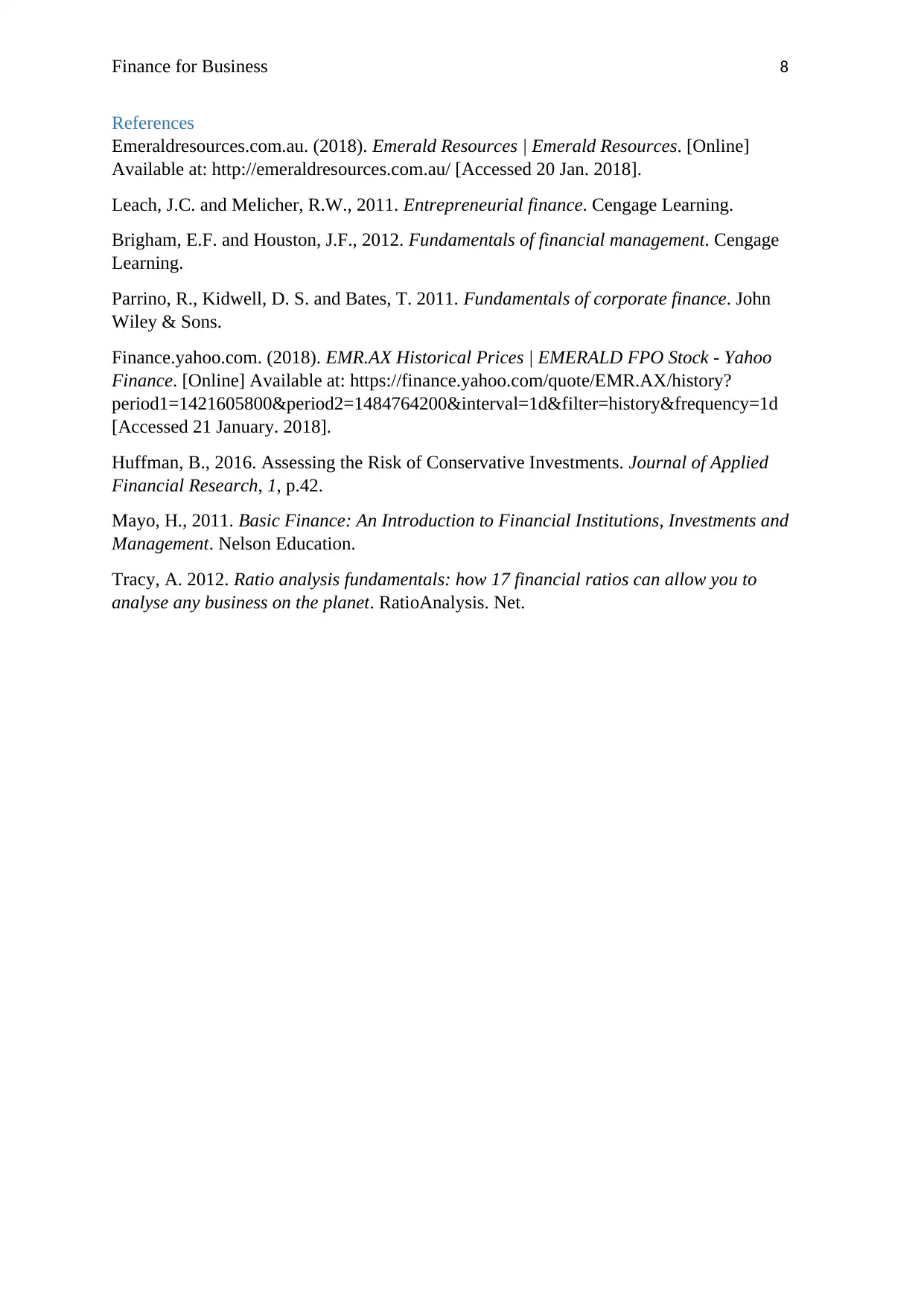
Finance for Business 8
References
Emeraldresources.com.au. (2018). Emerald Resources | Emerald Resources. [Online]
Available at: http://emeraldresources.com.au/ [Accessed 20 Jan. 2018].
Leach, J.C. and Melicher, R.W., 2011. Entrepreneurial finance. Cengage Learning.
Brigham, E.F. and Houston, J.F., 2012. Fundamentals of financial management. Cengage
Learning.
Parrino, R., Kidwell, D. S. and Bates, T. 2011. Fundamentals of corporate finance. John
Wiley & Sons.
Finance.yahoo.com. (2018). EMR.AX Historical Prices | EMERALD FPO Stock - Yahoo
Finance. [Online] Available at: https://finance.yahoo.com/quote/EMR.AX/history?
period1=1421605800&period2=1484764200&interval=1d&filter=history&frequency=1d
[Accessed 21 January. 2018].
Huffman, B., 2016. Assessing the Risk of Conservative Investments. Journal of Applied
Financial Research, 1, p.42.
Mayo, H., 2011. Basic Finance: An Introduction to Financial Institutions, Investments and
Management. Nelson Education.
Tracy, A. 2012. Ratio analysis fundamentals: how 17 financial ratios can allow you to
analyse any business on the planet. RatioAnalysis. Net.
References
Emeraldresources.com.au. (2018). Emerald Resources | Emerald Resources. [Online]
Available at: http://emeraldresources.com.au/ [Accessed 20 Jan. 2018].
Leach, J.C. and Melicher, R.W., 2011. Entrepreneurial finance. Cengage Learning.
Brigham, E.F. and Houston, J.F., 2012. Fundamentals of financial management. Cengage
Learning.
Parrino, R., Kidwell, D. S. and Bates, T. 2011. Fundamentals of corporate finance. John
Wiley & Sons.
Finance.yahoo.com. (2018). EMR.AX Historical Prices | EMERALD FPO Stock - Yahoo
Finance. [Online] Available at: https://finance.yahoo.com/quote/EMR.AX/history?
period1=1421605800&period2=1484764200&interval=1d&filter=history&frequency=1d
[Accessed 21 January. 2018].
Huffman, B., 2016. Assessing the Risk of Conservative Investments. Journal of Applied
Financial Research, 1, p.42.
Mayo, H., 2011. Basic Finance: An Introduction to Financial Institutions, Investments and
Management. Nelson Education.
Tracy, A. 2012. Ratio analysis fundamentals: how 17 financial ratios can allow you to
analyse any business on the planet. RatioAnalysis. Net.
⊘ This is a preview!⊘
Do you want full access?
Subscribe today to unlock all pages.

Trusted by 1+ million students worldwide
1 out of 9
Your All-in-One AI-Powered Toolkit for Academic Success.
+13062052269
info@desklib.com
Available 24*7 on WhatsApp / Email
![[object Object]](/_next/static/media/star-bottom.7253800d.svg)
Unlock your academic potential
Copyright © 2020–2025 A2Z Services. All Rights Reserved. Developed and managed by ZUCOL.
